COCCINIA
Coccinia
Wight &Arn., Prodr. Fl. Ind. Orient. 1: 347. 1834; Benth. & Hook.f., Gen. Pl. 1: 827. 1867; Cogn. in A. & C. DC., Monogr. Phan. 3: 528. 1881; Chakravarty, Monogr. Ind. Cucurbit. in Rec. Bot. Surv. Ind. 17(1): 116. 1959; Jeffrey, Kew Bull. 15(3): 339. 1962; Lu & Jeffrey, Fl. China 19: 52; Fl. North Amer. @ eFloras.org vol. 6;Nazim. & Naqvi, Fl. Pak @ eFloras.org p. 18.
Herbs, climbers or trailers. Stem glabrous or scabrous. Dioecious, rarely monoecious. Tendrils simple, rarely bifid. Leaves simple, petiolate, usually very variable in shape, 5- angular or 5-lobed, deltoid or rounded-cordate, glabrous or punctate on upper surface, rarely glandular beneath. Flowers unisexual, actinomorphic, epigynous, medium to large, white or brownish yellow, often green veined. MALE FLOWERS: Solitary, clustered or shortly racemose, rarely in short spikes. Calyx tube short, campanulate or turbinate, teeth 5. Corolla large, campanulate, shortly or acutely 5-lobed. Stamens 3, inserted on base of calyx tube; filaments connate into a central column, rarely free; anthers connivent, one 1-celled, two 2-celled, anther cells reflexed, connective not produced. Pistillodes absent. FEMALE FLOWERS: Solitary, rarely racemose. Calyx and corolla as in male flowers. Staminodes 3, oblong or subulate. Tricarpellary, syncarpous, ovary ovoid, oblong to linear, smooth, placentas 3. Style slender, filiform; stigmas 3. Fruit small to moderately large, globose to elongate, baccate (berry-like), indehiscent, many-seeded. Seeds small,compressed, ovate, marginate.
28 species
Coccinia grandis
Coccinia grandis
(L.) Voigt, Hort. Suburb. Calcutt. 59: 1845.; Jeffrey in Milne-Redhead & Polhill, Fl. Trop. E. Afr. (Cucurbitaceae) 68. 1967; Stewart in Nasir & Ali, Ann. Cat. Vasc. Pl. W. Pak. and Kashm. 703. 1972; Jeffrey, Kew Bull. 34: 801. 1980; Fl. China @
eFloras.org p. 19; Meeuse, Bothalia 8: 96. 1962; Chakravarty, Fasc. Fl. Ind. 11: 24, 25.f. 1-9. 1982; Bryonia cordifolia L. 1753; Cogn. in DC. Monogr. Phan. 3: 529. 1881; Chakravarty in Rec. Bot. Surv. Ind. 17(1): 117. 1959; Bryonia grandis L. Mant. Pl. 1: 126. 1767; Coccinia indica Wight and Arn. var. palmata Wight and Arn., Prodr. 348. 1834.
Perennial herb, extensive climber, dioecious Stem slender, slightly woody, many branched, angular, glabrous. Tendrils filiform, up to 15 cm long, glabrous, simple. Petiole slender, 2-5 cm long, rough, pubescent; leaf blade 5-13 cm x 5-11 cm, 3-(5)-lobed or -angled, 5-nerved at base, scaberulous, leaves with few glistening glands at both sides of midrib towards base, margin of leaf and back of nerves. Flowers unisexual, actinomorphic, epigynous, solitary, 3-4 cm long, white. MALE FLOWERS: Pedicel slender, 0.5-4 cm, glabrous. Calyx tube broadly campanulate, 4-5 mm, segments 5, linear-lanceolate, ca. 5 mm x 1 mm, apex orange, glandular. Corolla campanulate, white, 2.5-4 cm long, ca. 4.5 cm across; tube ca. 1-2 cm long; 5-lobed, lobes 1.5-2.0 cm, ovate-triangular, green nerves at back prominent, outside glabrous, inside pubescent. Stamens 3, inserted at base of calyx tube, one 1-celled and two 2-celled; filaments and anthers connate; filaments 2-3 mm; anthers subglobose, 6-7 mm, reflexed, connective not produced. FEMALE FLOWERS: Pedicel slender, 1-3 cm. Calyx and corolla as in male flowers. Staminodes 3, 1-3 mm, nearly subulate, villous at base. Ovary oblong, 12-15 mm, placentas 3, ovules numerous, horizontal, placentation parietal; style ca. 6 mm, filiform; stigmas 3, 5-6 mm, each bifid. Fruit green when young and scarlet when ripe, ovoid or oblong, 2.5-5 cm x 1.2-2.5 cm, apex beaked. Seeds yellow, oblong, compressed, 6-7 mm x 2.5-4 mm, apex rounded.
Common Names: Ivy Gourd, Scarlet Gourd, Kowai fruit; Kundru (Hindi)
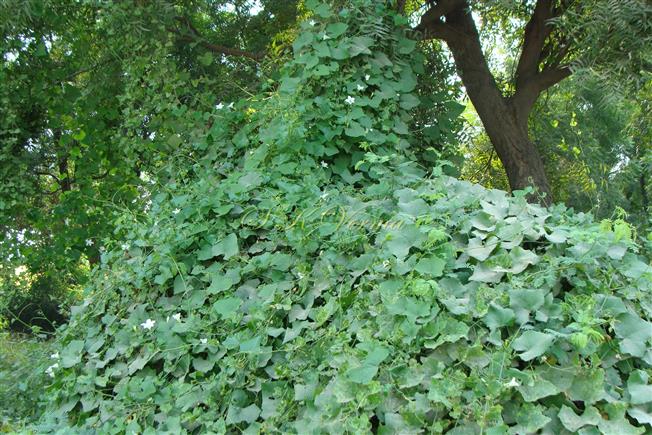
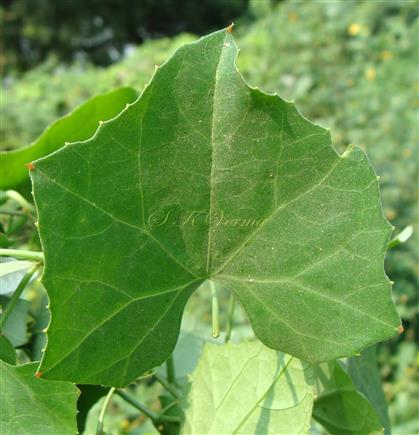
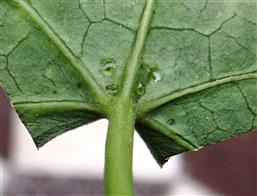
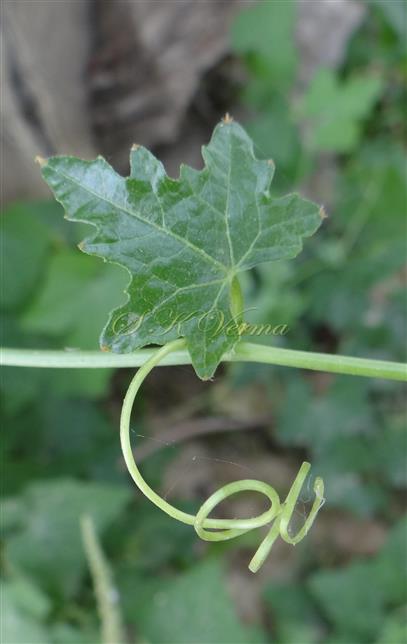
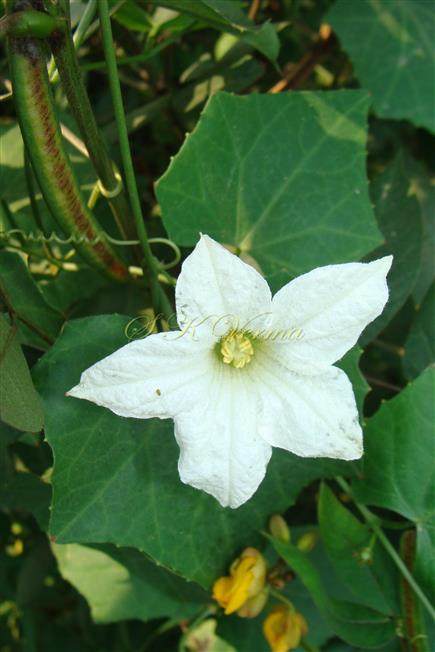
-DSC00828.jpg)
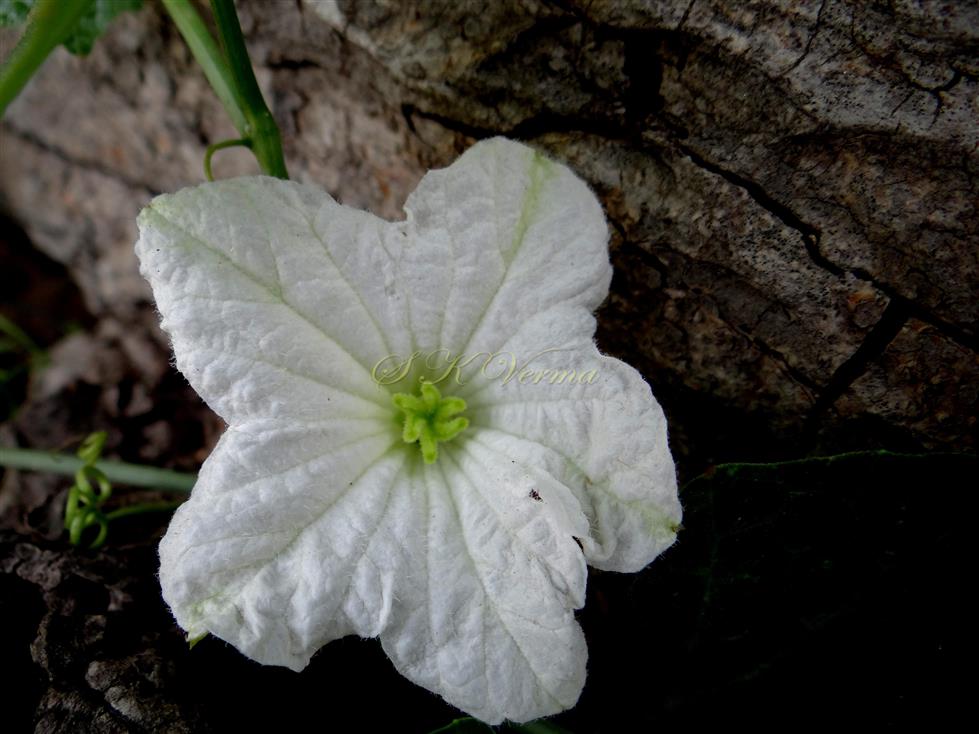
-DSC05722.jpg)
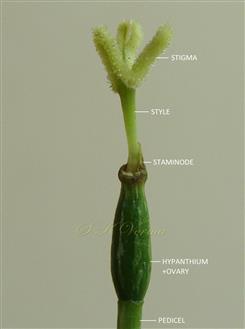
 and Leaf-DSC05726.jpg)
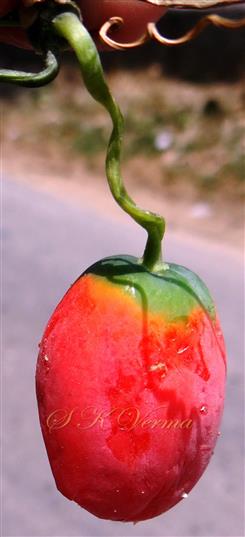






-DSC00828.jpg)

-DSC05722.jpg)

 and Leaf-DSC05726.jpg)
